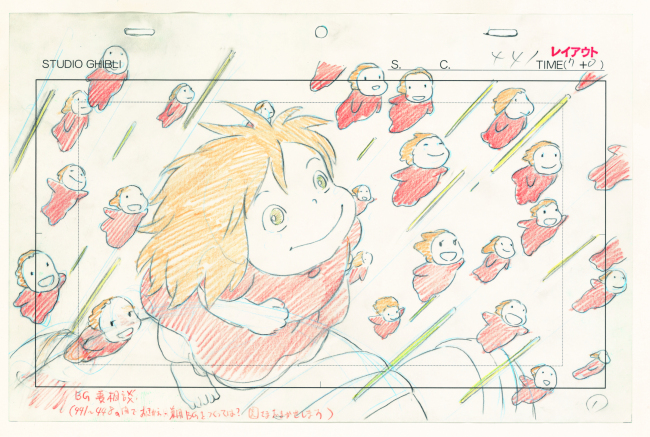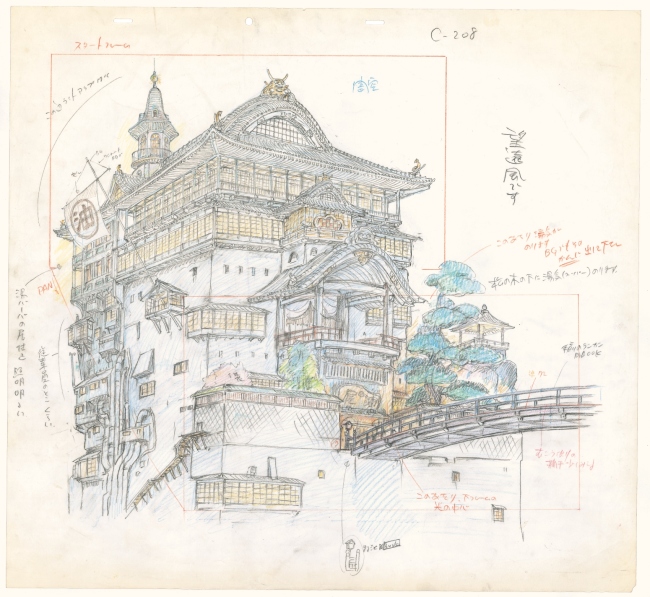Blueprints behind Miyazaki’s magic
About 1,300 layout designs produced by animation powerhouse Studio Ghibli are on display at Seoul Arts Center’s Hangaram Design Museum
By Lee Woo-youngPublished : June 24, 2013 - 19:47
The plain two-dimensional animation images created by Japanese animation film director Hayao Miyazaki have continued to fascinate viewers even after the arrival of the dazzling three-dimensional images by major studios.
It might be the scene in which the young witch Kiki leaves her home to explore the world in “Kiki’s Delivery Service,” or Totoro waiting at a bus stop holding a small umbrella that barely covers his head that brought up nostalgia in viewers who have fond memories of growing up watching the characters.
It might be the scene in which the young witch Kiki leaves her home to explore the world in “Kiki’s Delivery Service,” or Totoro waiting at a bus stop holding a small umbrella that barely covers his head that brought up nostalgia in viewers who have fond memories of growing up watching the characters.

The unique fairy-tale characters look utterly convincing in the world of Miyazaki. And its dream-like, yet detailed depiction of the imaginary leaves viewers guessing about the world inside the director’s head.
The memorable scenes are being revived at an exhibition at Hangaram Design Museum of the Seoul Arts Center in Seocho-dong, Seoul that displays the layout designs of animation movies produced by Miyazaki and his Studio Ghibli since 1985.
A layout design is a drawing of each scene and includes all the relevant information and visuals to be shown on screen.
“Miyazaki even wrote the speed of clouds on a layout design,” said Kazuyoshi Tanaka, a producer from Studio Ghibli, at the press guided tour of the Studio Ghibli Layout exhibition in Seoul last week.
The technique was first tried by Miyazaki during the making of one of his earlier works, “Heidi a Girl of the Alps” in 1974. The layout design has all the information needed to make a scene into a movie, such as the position of a character against the background, their movements and speed of motion.
The exhibition is a comprehensive display of 1,300 layout designs from animated films produced by Studio Ghibli since 1985, when the studio was established, and some old works Miyazaki created before the studio was founded.
The layout design process is an important stage that cannot be missed in the animation process of Studio Ghibli. Based on the layout design, the studio divides the work: background images and characters are painted, images are combined and filmed.
The layout designs shown at the exhibition are drawn not only by Miyazaki himself, but also a team of layout design staff. But, important images are mostly drawn by Miyazaki or staff assigned by him such as the opening image of “Nausicaa of the Valley of the Wind.”
“He is a genius. He just takes images in his head puts them onto paper,” said Kazuyoshi.
According to Kim Dong-wan, curator of the exhibition, the images rely solely on Miyazaki’s imagination.
“Miyazaki doesn’t take pictures of the places he went to or objects he saw. He thinks the pictures based on reality block the flow of his imagination. He rather records the scenes and time in his memory and brings them out later for his story,” wrote Kim in the exhibition catalogue.

The memories may not be based on reality, but they create a whole new strange, yet convincing world in movies like “Spirited Away” and “Howl’s Moving Castle.”
Movies produced by Studio Ghibli have never failed to be included on hit movie lists in Japan. They have been also popular in Korea. “Spirited Away,” produced in 2001 by Miyazaki, attracted around 2.4 million viewers and “Howl’s Moving Castle” 3 million in 2004.
“Spirited Away” also won the Golden Bear at the 2002 Berlin International Film Festival. It was the first time an animated film won the international film award.
The exhibition continues through Sept. 22. The gallery is closed on the last Monday of the month.
Admission is 15,000 won for adults, 12,000 won for teenagers and 10,000 won for children.
For more information, call 1688-6875.
By Lee Woo-young (wylee@heraldcorp.com)








![[KH Explains] Hyundai-backed Motional’s struggles deepen as Tesla eyes August robotaxi debut](http://res.heraldm.com/phpwas/restmb_idxmake.php?idx=644&simg=/content/image/2024/05/16/20240516050605_0.jpg&u=20240516155018)









![[Today’s K-pop] NewJeans hits 600m Spotify streams with ‘Ditto’](http://res.heraldm.com/phpwas/restmb_idxmake.php?idx=642&simg=/content/image/2024/05/17/20240517050510_0.jpg&u=)